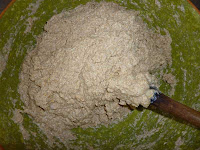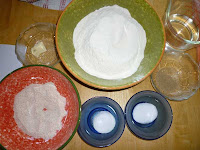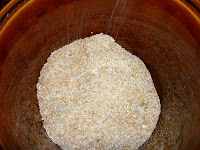I revisit the Struan
side-by-side with Reinhart's Transitional Multigrain Sandwich Bread
My son said he tried the first
multigrain struan that I made, when last he was home, and said that it tasted good, but he thought it was a bit stale. Although I personally didn't care that much for the taste (perhaps that was one of the reasons it was going stale, I was eating other breads that I thought were better), I was feeling a bit guilty that I hadn't given the recipe an honest try. I knew I had to revisit the loaf, which Reinhart describes as the bread that launched him on his baking career.
Part of the problem was, I didn't make the original
struan properly. Not really knowing
which grains to put together, I simply used a multigrain
flour -- and, even at the time I chose to bake it this way, I felt I was cheating. I had to give the struan one more go. But which grains would give the bread recipe a good run for its money?
The answer was actually found when I looked at the
next bread in sequence in the book. This is another Multigrain Bread, but Reinhart gives it the name '
Transitional Multigrain Sandwich Bread'. It is transitional because it does have
some all purpose flour, in addition to whole wheat and other whole grains. That gave me the idea of making one of these 'Transitional Multigrain Sandwich Breads' alongside the 'Multigrain Struan'. I would make the breads with
essentially the same grains -- only the Struan would have
only whole wheat flour, and the transitional loaf would have
some all-purpose.
That meant that I would use Reinhart's suggestion for the grains used in the soaker of the transitional multigrain bread in the Struan as well. The recipe for the struan calls for 170 g of cooked or uncooked grains -- and Reinhart gives suggestions for which of the grains he thinks should be pre-cooked, and which are acceptable to just toss into the soaker uncooked. There are so many variables, that is one of the reasons I just threw up my hands and opted for a multigrain flour. But here, in the transitional loaf, we have a very specific list of grains to use as ingredients:
- Whole wheat flour
- Rolled oats
- Cornmeal
Cooked Brown rice (I used cooked wild rice)- Bran
- Flaxseeds
I had to run out to the store to get Flaxseeds. I'm sure I had some, but I just couldn't find my stash, so off I went. I also substituted the Brown rice. I almost used Basmati rice, but in my quest for the flax, I came across some wild rice I had. I boiled it for about 30 minutes, and I was afraid it might not be enough.
The total of the amounts of the multiple grains in this transitional loaf that Reinhart calls for is 169.5 g -- so very close to the 170 g called for in the Struan's soaker, I felt justified in saying, "These are the same" (since my scale doesn't do partial grams anyway).
So one day when I awoke from working nights, I walked the dog and came back and threw together 2 multigrain soakers. In theory, I could have just done a double recipe, and just divided it on baking day. But I didn't, in case they needed to be baked at different times for whatever reason.
I did not put together the Biga at the same time. I would do that in the morning before falling asleep. It only needed 8 hours of sitting, and all that time it was to be in the refrigerator. I decided to do this when it would least impact my wife, who needs the space in the fridge and complains loudly when I put too many bread supplies in there. Friday seemed the perfect day, since she would be away.
So if the soakers are identical, what is the actual difference between the bigas? The transitional loaf calls for 227 g of all purpose flour, and the struan calls for the same weight in whole wheat flour. But the water amounts vary, and here we learn something instructional:
the whole wheat flour requires more water than the all purpose flour, to make a kneadable dough. I have read many times that this is because the bran soaks up more of the water.
The soaker hydration is essentially 50%. I worked out the hydration percentages of the biga for each:
all purpose flour's hydration for biga: 63%
whole wheat flour's hydration for biga: 75%
There is also a difference in the construction of the final dough, although both are here adding a little additional whole wheat flour. The only extra hydration at this point comes from the oil (and possibly some of the sweetener, if for example, one uses honey -- but this time, I used brown sugar); but the struan uses another 56.5 g of the whole wheat flour, and the transitional multigrain bread uses only 28.5 g. I felt that this has pretty much the effect of bringing the total hydration for both loaves, in the final stage, to the same consistency (although I didn't figure out the math for that).
When I got home from working nights, I measured out the quantities for the 2 bigas, and kneaded the dough briefly as per instructions. I put them in the fridge until late afternoon; I also got the ingredients ready for the final doughs. Then I went to bed for some much needed sleep.
These Reinhart breads are not that difficult to put together, but it does require some organization of one's time. At 5 pm, I took the biga from the refrigerator; it would be 7 pm before I could combine them with the soaker and the final dough mix. Mixing the two breads separately might take 15-20 minutes, since I was taking my time, and taking lots of pictures. Then it would be another 1 1/2 hours minimum for them to rise before I could shape them; and another 1 1/2 hours minimum of proofing. The actual baking time was going to be about 40 minutes: so I was going to be awake until eleven or twelve o'clock tonight. Good thing I slept all day.
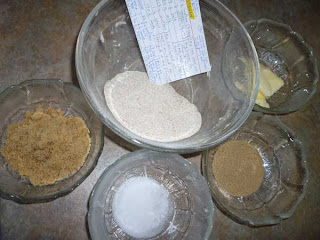
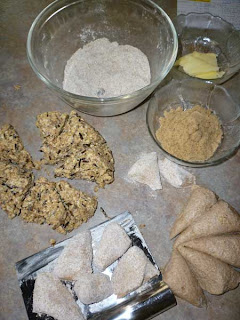
The mixing and kneading were a snap. I found the struan easier to work with. The transitional loaf was a lot wetter, curiously, since it had less hydration. When one is kneading these doughs, they rapidly warm up in your hands, and get very sticky. I had my water on hand, and when I dipped my hands into the bowl, it had the effect of cooling down the dough, but it made it a bit slipperier. It would stick to the countertop, and then I'd have to toss down a little bit of extra flour.
The only really noticeable difference in the doughs, other than the wetness I just mentioned, is that the one with the tiny bit of all purpose flour really comes together after the 5 minute rest, when you are kneading for the final minute. It is at this stage that you actually feel the gluten strands from the all purpose flour tugging together, lining up, stretching and pulling. I didn't get this same sense with the 100% whole wheat flour in the struan.
When the dough had risen 1 1/2 hours, I formed them into batards. They may not have risen to the full doubling point. Perhaps they required a full 2 hours or more. But I didn't wait. This could have been my ultimate downfall, and the cause of my ultimate disappointment (see below).
Both of the loaves were painted with egg white and sprinkled with poppy seed. The only difference is that one loaf has some all purpose flour, and is a little bit lighter in colour than the other.
Both loaves spread substantially sideways rather than rising upward during the final proofing before baking. This trend continued during the baking step. I did not score the loaves. There was very little oven spring, and that was the only cause for my disappointment. The loaves are very beautiful, but they are terribly flat.
To be fair, the transitional sandwich bread was designed -- they both were designed, really -- for a loaf pan, and they might not have spread sideways had I put them in one, or if I had let them proof in a couche. But I wanted to have them cook on some parchment paper, for easier transfer into the oven. And I wanted to have a batard shape, I love the look of these loaves and the nicer crust baking on a stone gives you compared to what you can get from a loaf pan. But I knew when I was forming the batard that there was no gluten cloak forming. I am assuming that I didn't allow the dough to rise long enough, or proof long enough.
When the loaves were finished, the whole house smelled marvelous. The next day I cut them open for a side-by-side taste test comparison: alone, with butter, toasted with butter, and toasted with butter and jam (one must be thorough!).
The verdict: the loaves are very similar in taste, only they strike the palate in slightly different ways. I think that the poppy seeds were a bit lost in the flavour of the whole wheat but Reinhart is right, they do nicely complement the transitional multigrain loaf. I think that the wild rice added something very interesting to the whole wheat struan; in the multigrain loaf, there was a different hit of carbohydrate, and the wild rice worked but didn't set it off as nicely. Both loaves had excellent crust and mouth feel. I found no overlying reason to prefer one over the other. But they are different in subtle ways I find difficult to describe.


Again, these are sweet loaves; but these come with a full, well-rounded flavour. I noticed that the whole wheat struan had oozed a tiny bit of liquid while baking; probably from the butter and brown sugar. I am not convinced that these loaves need to have sweeteners in the form of honey, agave, sugar or other substances; nor am I convinced that they need to have extra fat in the form of oil or butter added. I bake them that way now because that is the recipe I am trying -- my goal is to work my way through this book. But if I were to make the struan again, I would try to do away with them so that the whole grains could be more directly tasted. I think that the complex carbohydrates in the whole wheat and other cooked grains will provide enough flavour for the struan to offset any bitterness that Reinhart might be afraid of.
But then again, perhaps that is just my taste. I'm already sold on whole grains. I like their taste. I don't need to have it sugar-coated just to make me want to eat it.
I won't promise that I won't coat the bread with butter and sugary jam though.
Notes to Myself:
- Get another couche. Batards need it, especially high hydration loaves that spread before they rise. If each bread has its own couche, you can more easily transfer them into the oven or crock pot, or use one to cover a rising dough.
- Make sure that the dough doubles during the rise. If this happens in 1 1/2 hours, fine; but if not, wait the full 2 hours -- or more. Only if it doubles will the bread form a good gluten cloak during shaping, and it will have a better chance to rise.
- Taste tests by two independent taste testers agree: both of these loaves taste good, but they do taste different -- and the struan has more flavour. So why would anyone choose the Transitional loaf? If you have a choice, choose the struan.
- Try making the struan without the extra butter/oil and sugar.
- The egg white brushed on the crust made it a really nice consistency, and the poppy seeds stick to a proofing dough really well when you use egg white. Use egg white liberally for crusts.



